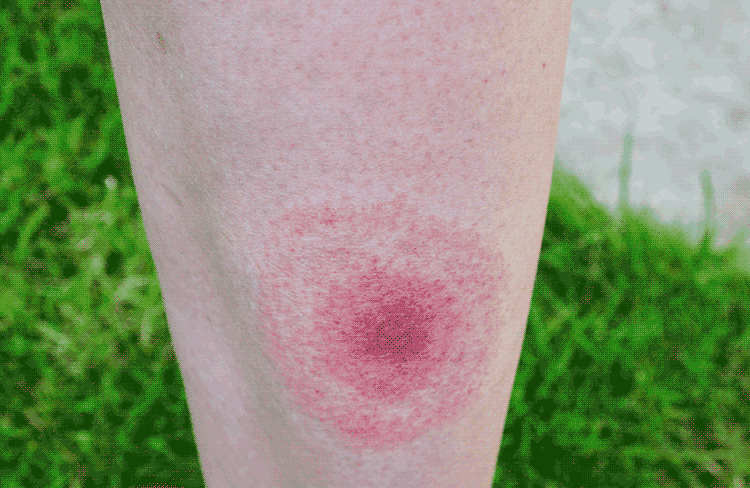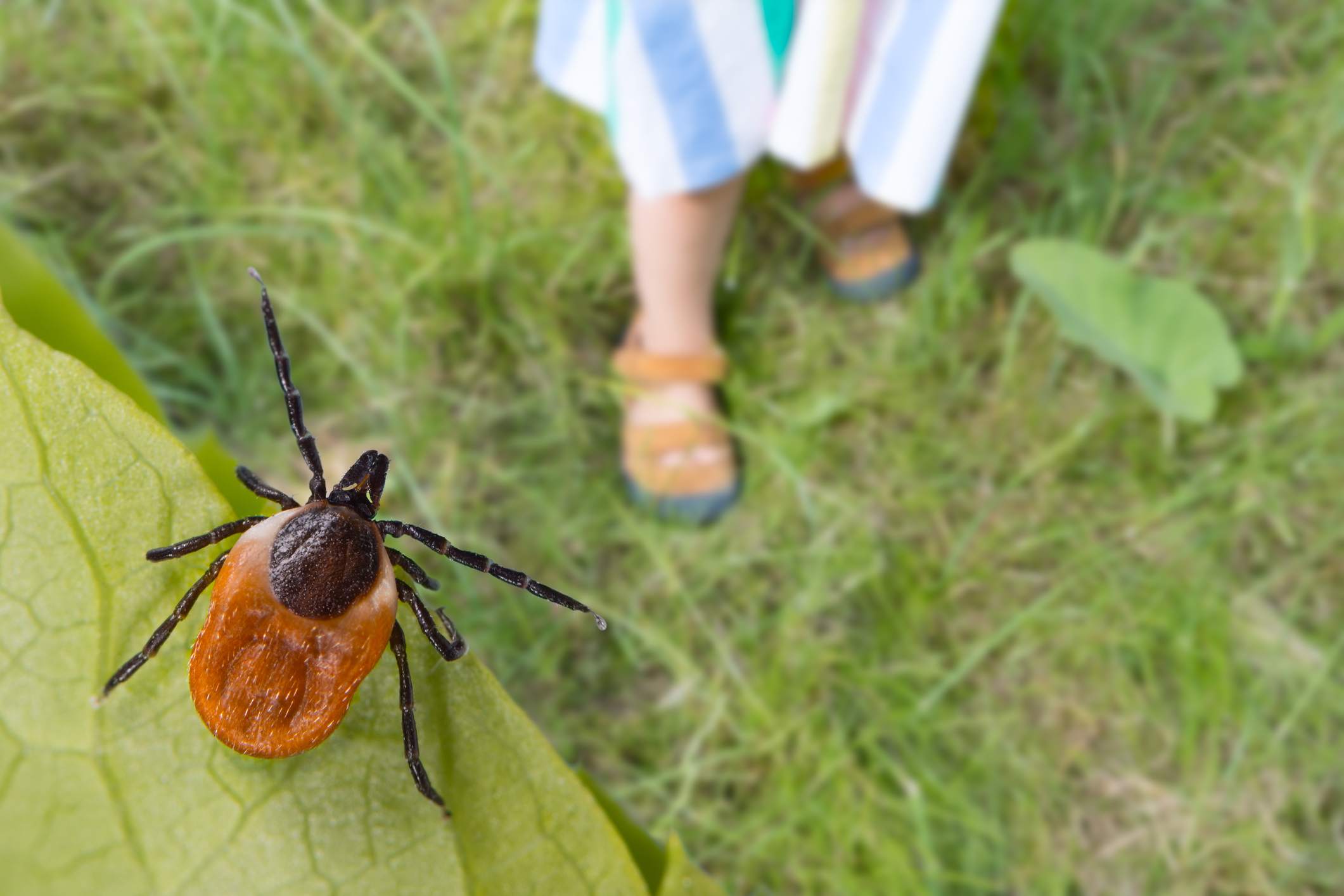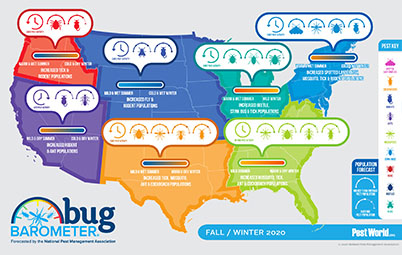Ticksdeveloper2024-10-24T06:26:24-05:00
Ticks
FACTS AND IDENTIFICATION
Color: Brown to rust colored following feeding.
Characteristics: Broadly oval and flat with four pairs of legs with claws.
Size: Adult females measure to about 2.7 mm in length. The males are smaller.
Potentially Dangerous: Yes
TICKS IN WISCONSIN
Wisconsin is home to several common tick species, including the American dog tick, black-legged tick (also known as the deer tick), and lone star tick. Each species has unique characteristics and poses different risks, especially when transmitting tick-borne diseases.
WHAT DO TICKS LOOK LIKE?
Ticks are tiny, ranging from a pinhead to a small apple seed. Adult ticks typically have eight legs, classifying them as arachnids, not insects. They are wingless and can travel up to several kilometers on their host or by crawling.
Ticks can vary in color, some reddish-brown, black, or dark brown. Their bodies are flattened and oval-shaped, and they often become more visible when engorged with blood after feeding. The black-legged tick, for example, has a distinct dark-colored scutum, or shield, on its back, while the American dog tick has a lighter brown appearance with white markings.
SIGNS OF A TICK INFESTATION
A tick infestation may be hard to detect since ticks are small and tend to hide in fur or clothing. If you or your pets are frequently bitten or you’re finding ticks on your clothing after being outdoors, you may have a tick problem in your yard or surrounding areas. Be looking for ticks on pets, especially around their ears, neck, and underbelly, where ticks often latch on. Also, check yourself after being in wooded or grassy areas, as ticks can crawl onto your skin without noticing.
HABITAT, DIET, LIFE CYCLE & BEHAVIORS
WHERE DO TICKS LIVE?
Ticks typically live in moist, humid environments, especially wooded or grassy areas, so avoid areas like this and walk in the center of trails. At home, they may be hiding in leaf litter or shrubs.
Ticks can travel a far distance with an unsuspecting host. If you live in a heavily wooded area or near water, they can enter yards via hosts such as wild animals. They prefer shady, moist areas, which is why it’s important to keep a clean, well-trimmed yard and avoid overwatering to prevent them from attaching themselves to you and your pets.
DIET
Ticks are obligate blood feeders, requiring blood meals at different life stages to grow and reproduce. Both nymphs and adult ticks feed on blood from various hosts, including mammals, birds, and reptiles. While ticks primarily seek out wildlife like deer and small rodents, they also bite humans and pets. Unlike other pests, ticks can go long periods without feeding, but they can remain attached for several days when they do feed.
LIFE CYCLE
Ticks undergo four life stages: egg, larva, nymph, and adult. Depending on the species and environmental conditions, a tick’s life cycle can take two to three years. After hatching from eggs, ticks enter the larval stage, seeking a small host for their first blood meal. Once fed, they molt into nymphs, a stage in which they can transmit diseases like Lyme disease. Nymphs then feed again before molting into adult ticks. Adult female ticks require one final blood meal to reproduce and lay thousands of eggs, restarting the cycle.
BEHAVIORS
Ticks exhibit behaviors that make them highly effective at finding and attaching to hosts. Known for “questing,” ticks climb to the tips of grass or shrubs and wait for a host to pass by. They can detect carbon dioxide, body heat, and movement, allowing them to sense when a potential host is nearby.
Ticks are not strong fliers or jumpers, so they use this method to latch onto animals or people as they brush against vegetation. Once attached, ticks use their specialized mouthparts to penetrate the skin and feed on blood.
ARE TICKS DANGEROUS?
Tick bites are harmless most of the time; however, they can carry several dangerous diseases. One is Lyme disease, which causes a bullseye-pattern rash to appear, as well as flu-like symptoms and fatigue. If left untreated, it can be deadly. Another rare disease is Powassan, which often goes undetected and attacks the central nervous system.

Ticks can also transmit diseases like Rocky Mountain spotted fever and tularemia, which are more common in other regions but still pose a risk. It’s essential to take any tick bite seriously and monitor for symptoms like fever, fatigue, and rash. If you suspect a tick-borne illness, it’s crucial to consult a healthcare provider.
HOW TO GET RID OF TICKS?
Once ticks have infested an area, they are extremely hard to get rid of. Contacting Terminix Wil-Kil Pest Control is ideal for controlling your tick problems. We offer effective residential and commercial tick control services that will help alleviate the pest problem. With targeted treatments that address all life stages of ticks, we help ensure a more comfortable and safer environment for your home or business.
TICK PREVENTION TIPS
Ticks can be very difficult to prevent. Cleaning a clean, well-trimmed yard will help but may not be practical, so contact Terminix Wil-Kil Pest Control at the first sign of a problem. Our tick control services are designed to reduce the tick population on your property,
NEED HELP WITH RESIDENTIAL PEST CONTROL IN YOUR WISCONSIN HOME?
Ticks are more than just a nuisance—they pose serious health risks to you, your family, and your pets. Acting quickly is essential if you’re dealing with ticks in your yard or have concerns about tick-borne diseases. Contact Terminix Wil-Kil for professional residential tick control services. Our expert team can assess your property, provide effective treatments, and offer long-term prevention strategies to keep ticks at bay.
FAQS
DO TICK BITES ITCH?
Yes, tick bites can itch, though the reaction varies from person to person. Some individuals may experience mild irritation, while others could develop more intense itching or redness at the bite site. In some cases, tick bites may not itch at all. If you develop an allergic reaction or the bite becomes more painful over time, it’s essential to consult a healthcare provider.
DO TICKS SLEEP?
Ticks don’t sleep in the traditional sense, but they do have periods of dormancy. During colder months or when conditions aren’t ideal for finding hosts, ticks enter a hibernation-like state to conserve energy. In this dormant phase, ticks can survive long periods without feeding.
DO TICKS JUMP?
No, ticks cannot jump. Unlike fleas or other insects that can leap onto hosts, ticks rely on a behavior known as “questing.” They climb to the tips of grass or shrubs and wait with their legs outstretched for a passing animal or human to brush against them. Once they make contact, they latch onto the host and begin feeding.
Related Post From Our Blog
developer2024-07-24T07:00:09-05:00June 19th, 2022|0 Comments
Ticks are a part of life in Wisconsin and across the Midwest. These tiny bloodsuckers latch on, and never want to let go. As the weather begins to warm up, ticks become more prevalent and [...]
Wil-Kil Pest Control2020-10-16T13:19:33-05:00October 16th, 2020|0 Comments
Learning to brave freezing cold temps and snowpocalypses is a prerequisite to be a Wisconsin resident – doing it in shorts is optional. In addition to our tundra-like weather, there’s another thing Wisconsinites will need [...]
developer2022-12-14T15:47:55-05:00June 10th, 2019|0 Comments
As we get closer and closer to summer in Wisconsin, outdoor activities are a must. Whether you are hiking or playing frisbee in your backyard, fewer layers and more visible skin come with a risk [...]
Ticks in Sun Prairie, WI
Terminix Wil-Kil Pest Control is a local Pest Control and Extermination company helping homeowners and businesses with pest issues across WI.
Serving Sun Prairie | Chippewa Falls | Menomonee Falls | Appleton
Madison | Green Bay | Eau Claire | Oshkosh | Kenosha | Racine





